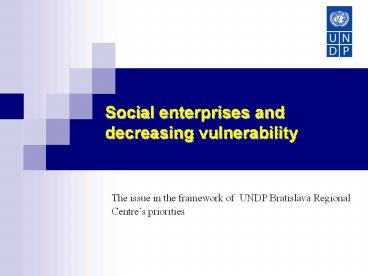Social%20enterprises%20and%20decreasing%20vulnerability - PowerPoint PPT Presentation
Title:
Social%20enterprises%20and%20decreasing%20vulnerability
Description:
The issue in the framework of UNDP Bratislava Regional Centre's ... Identify group-specific and factor-specific instruments to attenuate their consequences ... – PowerPoint PPT presentation
Number of Views:12
Avg rating:3.0/5.0
Title: Social%20enterprises%20and%20decreasing%20vulnerability
1
Social enterprises and decreasing vulnerability
The issue in the framework of UNDP Bratislava
Regional Centres priorities
2
Outline
- What is BRC doing
- Approach to vulnerability
- Why economy is seen as appropriate for decreasing
vulnerability? - Next steps
3
BRC architecture and territorial coverage
- Three thematic dimensions (practices) with set
of sub-practices - Democratic governance
- Environmental
- Poverty
- HD, MDGs and poverty monitoring (with social
inclusion increasingly gaining in significance) - Civil society engagement for poverty alleviation
- MDG support
- Private business engagement, UN Secretary General
Global Compact Initiative - Poverty reduction and trade
- Cross-cutting areas
- Gender
- ICT
- HIV/AIDS
- Country support team
4
Why involved in the RBEC region? Major challenges
- Strong core-periphery disparities
- Working poor phenomenon
- Unreformed social services
- Old industrialized regions (depressive urban
areas) - Single-factory towns poverty
- Rural poverty
- Increase in inequality
- Emergence of visible of losers of transition
(vulnerable groups)
5
Why involved in the region? Increase in inequality
6
Approach to vulnerability who are vulnerable?
- Group affiliation
- Roma? IDPs? Women? Youth?
- Individual status dimension
- Disabled
- Pre-retirement age unemployed
- Long-term unemployed
- Level of education, qualification
- Single parents
- Functional dimension
- Isolation (inaccessible social and physical
environment) - Access (lack of) to basic infrastructures
7
Dealing with vulnerability addressing
- Poverty and the risk of falling into poverty (not
just monetary) - Lack of educational opportunities
- Inadequate personal (physical) security,
- Poor housing
- Poor access to health care
- Closely related to the concept of human
security (security beyond security of
nation-states borders)
8
Closer look at HD and HS perspective to
vulnerability
- Vulnerability as a set of
- Socio-economic risks (household dimension)
- Personal risks (individual dimension)
- Environmental risks (territorial and spatial
dimension) - Vulnerability as capacity deficits to
- identify and avoid threats
- Identify group-specific and factor-specific
instruments to attenuate their consequences
9
Social enterprises as an instrument to address
vulnerability
- Entities sharing characteristics of business and
NGO/CSO sector - Main objective achieving social goals and not
profit (NGO face) - Major instrument for reaching the objective
operation following business models - Dual role of the target group
- Active participants
- Major client
- Particularly suitable for excluded groups
- Different from
- Market providers of social services
- Entities distributing social assistance
10
Unlike targeted group approach, social
enterprises can
- Target the assistance and increase both its
effectiveness and efficiency - Provide wide range of positive externalities
- Actively involve the communities
- Decrease free riders perception and thus
improve social cohesion - Decrease dependency
- Decrease overall costs of addressing
vulnerability and social inclusion - Be group neutral and open to various vulnerable
groups - Falls into EC priority work on social economy
11
Why social enterprises for vulnerable groups? The
Roma
- Social inclusion of Roma faces problems
- despite the plethora of initiatives?
- Because of the plethora of initiatives?
- Policies so far contributing to dependence
- Capacity of the stakeholders rarely being
developed - Strong corporate interests involved in Roma
inclusion - vulnerability-based approach necessary
targeting Roma because they are vulnerable and
not because they are Roma - Social enterprises can be helpful to decrease
dependency and social distance
12
The current project
- A regional initiative launched by BRC in 2006 to
assess the feasibility and practice of Social
Enterprises in NMS, the Western Balkans, and the
CIS - Set of national studies in a regional framework
- Common denominator post-socialist specifics of
the third sector - Country specifics address nationally-relevant
challenges regarding vulnerability and social
inclusion
13
The regional component
- Introduces regionally adequate definitions of
social enterprises - Estimates contributions of social enterprises to
the process of social inclusion (both from a
social and economic point of view) - Suggests criteria for measurement (three economic
and three social criteria). - Economic
- An economic activity producing goods and/or
selling services - A degree of autonomy
- A trend towards paid work
- Social
- An explicit aim to benefit the community or a
specific group of people - Decision-making power not based on capital
ownership - Exclusion of profit-maximising organizations
14
The future perspectives
- Within this particular project
- Future support to legal frameworks (in Poland and
Serbia) - Launch of publication in Barcelona
- Project Development based on findings
- Broader framework
- Constituting social economy as a programmatic
area of BRC - Integrating the work on supporting social economy
into overall vulnerability-targeted endeavors - Linking social enterprises to social inclusion
monitoring (sets of indicators, monitoring
frameworks)































